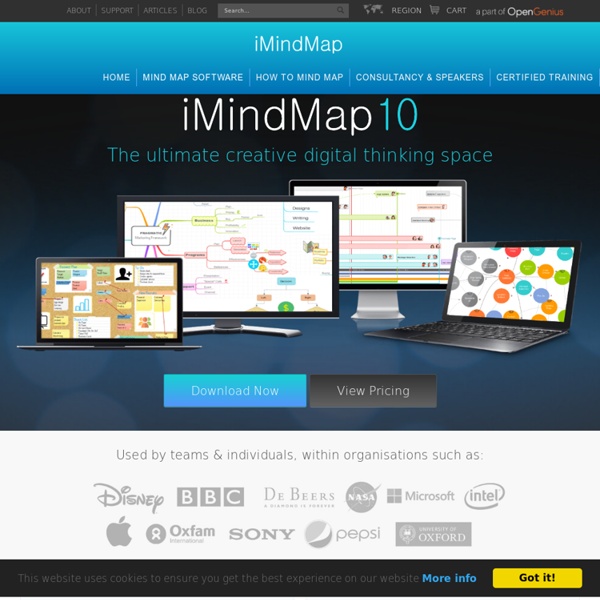The Age of Coworking: Collaborative Consumption for the Creative Community
Report Maria Popova Many coworking spaces are housed in meticulously designed lofts. Photo from Green Spaces, NYC.
Using FreeMind
Using FreeMind In this tutorial, we'll look at creating a mind map. Just to remind you, a mind map is a hierarchical set of nodes, connected together by edges (lines), which are displayed as a graphical map. The guide's choice of mind mapping software is FreeMind, an open source program, by Jörg Müller. If you haven't already downloaded and installed this program, the guide's article FreeMind – Mind Mapping will show you what to do.
Wisemapping
A mind map is a diagram used to represent words, ideas, tasks, or other items linked to and arranged around a central key word or idea. Especially in British English, the terms spidergram and spidergraph are more common,[1] but they can cause confusion with the term spider diagram used in mathematics and logic. Mind maps are used to generate, visualize, structure, and classify ideas, and as an aid to studying and organizing information, solving problems, making decisions, and writing. The elements of a given mind map are arranged intuitively according to the importance of the concepts, and are classified into groupings, branches, or areas, with the goal of representing semantic or other connections between portions of information.
Free mind mapping (and related types) software
I see regular inquiries on Twitter and in forums from people looking for free software to support visual thinking. To provide answers, InformationTamers have put together 14 pages to help you find the one for your needs. These show the platform, a screen thumbnail and a link for more information in each case.
Coworking global survey: 42% of all coworkers report earning a higher income since joining a coworking space
A few days ago, Deskmag, the coworking magazine, launched a worldwide survey, in order to investigate the motivations of the users of coworking spaces. Coworking Europe 2010 is proud to be a partner of this great initiative. The survey collected answers from 661 coworking space users around the world, originating from 24 different countries. The evaluation of the data requires a little time, but a few preliminary results are already available, says Deskmag. Here they are :
18 Free Mind Mapping Tools for Teachers and Students
1- SpiderScribe This is a great mind mapping tool that allows users to easily visualize their ideas by connecting various pieces of information together and create free style maps. It also combines elements like text, images, files, calendar events and geographic locations. 2- EdistormEdistorm is a great web2.0 tool for educators. It allows you to work on your ideas during a structured brainstorming and organize them into sticky notes for others to see .
Mind Mapping Uses in Education
This guest post was written by Richard – a mind mapping specialist at MindMeister – a leading provider of mind mapping solutions. Mind mapping is fast becoming a must have tool in education, increasing in popularity with both students and teachers alike. Many school districts and universities across Europe, Canada and the US have turned to mind mapping software as their cloud based solution for file sharing, online collaboration and brainstorming.
The Ultimate Dropbox Toolkit & Guide
Dropbox, the app we all (at least many of us) know and love, has a plethora of advanced uses to make life so much easier in managing data between multiple computers and online. We’ve posted several roundups of tips and tricks for Dropbox and now we present our ultimate toolkit and guide. We’ve pulled all our tips and tricks together and added quite a few more. Additionally, share your Dropbox tips and tricks and we’ll update the list to share the fun with everyone. Dropbox?
Mind map
A mind map about educational technology A mind map is a diagram used to visually organize information. A mind map is hierarchical and shows relationships among pieces of the whole.[1] It is often created around a single concept, drawn as an image in the center of a blank page, to which associated representations of ideas such as images, words and parts of words are added.
Terms of Use
Mind42 is a service provided by IRIAN Solutions Softwareentwicklungs- und Beratungsgesellschaft mbH (in short terms “IRIAN”), Schottenfeldgasse 20/6a, 1070 Vienna, Austria, Europe. Any service provided by IRIAN and your use of those services is subject to the terms of a legal agreement between IRIAN and you. The principal place of business for IRIAN is the company’s address mentioned above. This descriptive writing explains how the agreement is set up and describes some of the underlying terms of agreement. This document reflects a minimum set of terms and conditions that always apply unless otherwise agreed in writing with IRIAN.
14 Brilliant Uses for Mind Maps – Engage Your Whole Brain
Mind maps engage your whole brain and allow you to see the big picture. A mind map is a whole-brain method for generating and organizing ideas which is largely inspired by Leonardo da Vinci’s approach to note-taking. The concept was brought into the mainstream by Tony Buzan and is based on patterns found in nature, and on research on how humans think and how the brain works.



